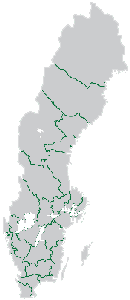Sustainability |
| When discussing sustainability today, one soon realizes that it is a complex issue with many opinions and tough debates. Questions that arise include: how should the forest be used? Who owns the property and how can it be used to capture carbon dioxide for everyone's benefit? How will the forest be enough for all the different products and industries that want to use it? The EU also has new laws and regulations. For sawmills like ours, it is difficult to navigate and even harder to know what is fact and what is opinion or self-interest. At Boda Saw, we are open about the fact that our impact on the environment today involves a CO2 emission of 26 kg per produced cubic meter of sawn timber. This includes all steps in the process from forestry (with harvesters and loggers and transport) to sawing, internal logistics, additives and electricity usage. We do not take into account and deduct the forest's ability to capture CO2 and grow in this figure. On average, we consume 45 KWh of electricity per sawn cubic meter, which we believe is a very low average compared to other larger sawmills. This is because the faster the motors and drives run during production, the more power and energy is used. As a smaller producer, we do not require large drives and motors to keep production going. |
| We also invest in new control systems and technology for both our saw line and our lumber drying system, which enables us to reduce our total electricity usage. If we can reduce electricity consumption through energy efficiency, that energy can be used elsewhere in society and we can lower our electricity costs. Today, we buy our raw lumber from an average distance of about 67 km, which we think is a low average for the industry and reduces our environmental impact. It is important not to confuse this with our catchment area, which is measured differently and refers to the maximum distance from which the raw material is collected. Sometimes it is 15 km and sometimes it can be up to 120 km. The average for 2021-2022 was 67 km. Because 90-95% of our carbon dioxide emissions come from forestry and transport of heavy lumber, we believe sawmills should be located where the raw material is found to minimize environmental impact. It is not sustainable or logical to use fossil fuels to transport heavy lumber that can be processed locally into finished products. At Boda Saw, we are constantly working to improve our environmental performance and reduce our impact on the environment. We believe that this is important not only for the environment, but also for our customers and future generations. |
|
Boda Såg I Dalarna AB Tel: +46 246-511 30 Follow Boda såg on: |
We guarantee
Boda sawmill in Dalarna AB guarantees by our suppliers that the timber is not derived from:
- Illegal disforestation
- Forest areas where traditional or civic rights abuses
- Forests where high conservation values are threatened
- Genetically engineered trees
- Natural forests that have been fell for the purpose to use the area to plantations or non-forest use.





